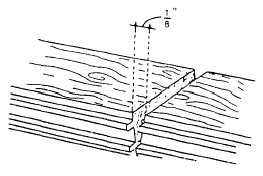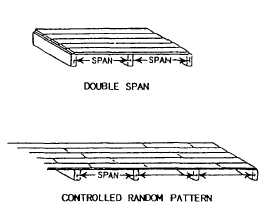used for flat or low-pitched roofs in post-and-beam
construction. Single tongue-and-groove decking in
nominal 2 by 6 and 2 by 8 sizes is available with the
V-joint pattern only.
Decking comes in nominal widths of 4 to 12 inches
and in nominal thicknesses of 2 to 4 inches. Three- and
4-inch roof decking is available in random lengths of 6
to 20 feet or longer (odd and even).
Laminated decking is also available in several
different species of softwood lumber: Idaho white pine,
inland red cedar, Idaho white fir, ponderosa pine,
Douglas fir, larch, and yellow pine. Because of the
laminating feature, this material may have a facing of
one wood species and back and interior laminations of
different woods. It is also available with all laminations
of the same species. For all types of decking, make sure
the material is the correct thickness for the span by
checking the manufacturer’s recommendations. Special
load requirements may reduce the allowable spans.
Roof decking can serve both as an interior ceiling finish
and as a base for roofing. Heat loss is greatly reduced
by adding fiberboard or other rigid insulation over the
wood decking.
INSTALLATION.— Roof decking applied to a flat
roof should be installed with the tongue away from the
worker. Roof decking applied to a sloping roof should
be installed with the tongue up. The butt ends of the
pieces are bevel cut at approximately a 2° angle (fig.
3-4). This provides a bevel cut from the face to the back
to ensure a tight face butt joint when the decking is laid
in a random-length pattern. If there are three or more
supports for the decking, a controlled random laying
pattern (shown in figure 3-5) can be used. This is an
economical pattern because it makes use of
random-plank lengths, but the following rules must be
observed:
Stagger the end joints in adjacent planks as
widely as possible and not less than 2 feet.
Separate the joints in the same general line by at
least two courses.
Minimize joints in the middle one-third of all
spans.
Make each plank bear on at least one support.
Minimize the joints in the end span.
The ability of the decking to support specific loads
depends on the support spacing, plank thickness, and
span arrangement. Although two-span continuous
layout offers structural efficiency, use of random-length
Figure 3-4.-Ends of roof decking cut at a 2° angle.
Figure 3-5.-Plank decking span arrangements.
planks is the most economical. Random-length double
tongue-and-groove decking is used when there are three
or more spans. It is not intended for use over single
spans, and it is not recommended for use over double
spans (see figure 3-5).
NAILING.— Fasten decking with common nails
twice as long as the nominal plank thickness. For widths
6 inches or less, toenail once and face-nail once at each
support. For widths over 6 inches, toenail once and
face-nail twice. Decking 3 and 4 inches thick must be
predrilled and toenailed with 8-inch spikes. Bright
common nails may be used, but dipped galvanized
common nails have better holding power and reduce the
possibility of rust streaks. End joints not over a support
should be side-nailed within 10 inches of each plank
end. Splines are recommended on end joints of 3- and
4-inch material for better alignment, appearance, and
strength.
Wood Fiber
All-wood fiber roof decking combines strength and
insulation advantages that make possible quality
construction with economy. This type of decking is
weather resistant and protected against termites and rot.
3-5



